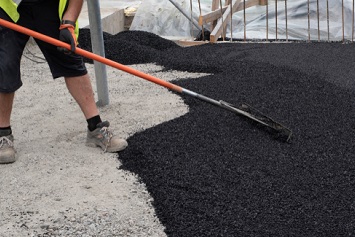Recycled tire crumb rubber has a variety of potential uses in facility design, from flooring to mulching to playgrounds or playing fields. The EPA, the Centers for Disease Control and Prevention/Agency for Toxic Substances and Disease Registry, and the Consumer Product Safety Commission have released the first report in their investigation into recycled tire crumbs, with a focus on the chemicals are contained in the material.

Patnaree Asavacharanitich / Shutterstock.com
The two-volume report (investigation results and appendices) is part of the “largest tire crumb rubber study conducted in the United States,” say the agencies. The report covers characterization of tire crumbs—that is, identifying the materials that comprise tire crumbs and their emissions. The projected second volume will assess human exposure or how people come into contact with tire-crumb materials, how often, and for how long. The two reports are not human health risk assessments, although the agencies believe the reports will be useful in informing future screening-level health risk assessments and identifying data gaps.
In writing the report, the agencies made use of existing research and also collected and analyzed samples from 40 outdoor and indoor synthetic turf fields around the country and from nine tire recycling facilities.
Federal Action Plan
The completed and projected work makes up a Federal Research Action Plan with four “high-level” research objectives:
- Determine key knowledge gaps related to chemical characterization, exposure, and human health hazards.
- Identify and characterize chemical compounds found in tire crumb used in artificial turf fields and playgrounds.
- Characterize exposures, or how people are exposed to these chemical compounds based on their activities on the fields.
- Identify follow-up activities that could be conducted to provide additional insights about potential risks.
What Is It?
Tire crumbs are small pieces of recycled tires that have been used since the 1960s in the construction of synthetic turf fields. These fields are now in their third generation, wherein tire crumbs are used to fill the spaces between polyethylene yarn fibers. Sometimes mixed with sand or other raw material, the tire crumb is added for ballast, support for the synthetic grass blades, and cushioning for field users. There are between 12,000 and 13,000 indoor and outdoor synthetic turf fields in the United States, with 1,200 to 1,500 new installations each year. Millions of people use and/or work on these fields.
The agencies note that concerns have been raised about the potential adverse health effects of chemical exposures. There is additional concern about the potential for exposure to microbial pathogens at synthetic turf fields. For example, methicillin-resistant Staphylococcus aureus (MRSA) has caused outbreaks among athletic teams, and artificial turf has been implicated as a fomite in transmission of MRSA among college athletes.
Constituents
According to the report, tires are manufactured with a range of materials, including rubber and elastomers; reinforcement filler material; curatives, including vulcanizing agents, activators, and accelerators; antioxidants and antiozonants; inhibitors and retarders; extender oils and softeners; phenolic resins and plasticizers; metal wire; polyester or nylon fabrics; and bonding agents. Chemicals of concern range from polycyclic aromatic hydrocarbons (PAHs) in carbon black to zinc oxide (ZnO), which is used as a vulcanizing agent and may contain trace amounts of lead and cadmium. Chemicals in many other classes may be used in tires, as well, including sulphenamides, guanidines, thiazoles, thiurams, dithiocarbamates, sulfur donors, phenolics, and phenylenediamines.
In addition to chemicals used in their production, tires may also pick up and absorb chemicals over their lifetime of use. Also, once installed on a field, tire crumb rubber may serve as a sorbent for chemicals in the air and in dust that fall onto the field. For example, one laboratory reported irreversible adsorption of volatile organic compound (VOC) and semi-volatile organic compound (SVOC) analytes spiked onto tire crumb rubber. Alternatively, the tire crumb rubber may also emit VOC and SVOC species into the air, especially at higher outdoor temperatures. Users of synthetic turf fields with tire crumb rubber infill can potentially be exposed to these chemicals in a variety of ways, including through inhalation, when their skin contacts the material, and/or by ingesting the material.
Exposure May Be Limited
In addition to constituent characterization, the agencies’ conclusions included a finding that vaporization and weathering appeared to lead to lower concentrations of many organic chemicals over time, particularly for outdoor fields, but this may have been a factor of the initial composition of the crumb rubber. Also, levels of organic chemicals tended to be higher for indoor fields compared with outdoor fields.
Overall, the research “supports the premise that while many chemicals are present in the recycled tire crumb rubber, exposure may be limited based on what is released into air or biological fluids,” the agencies state. But, again, they emphasize, “The study activities completed as part of this multi-agency research effort were not designed, and are not sufficient by themselves, to directly answer questions about potential health risks.”
